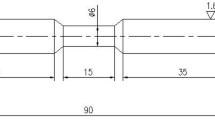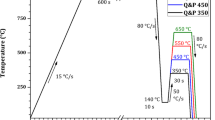Abstract
Fatigue damage of rail steel is an important issue affecting economic and human safety. In this paper, the effect of different quenching rates on the fatigue crack growth of hypereutectoid rail is analyzed. The material parameters C and m of the Paris formula are measured. The results show that an increase in cooling rate of rail decreases the value Paris law parameter C, increases the value m and decreases fatigue crack growth rate. This can be attributed to the decreased in the lamellar spacing and cluster diameter of the pearlite with an increase in cooling rate. More specifically, the smaller lamellar spacing and the cluster diameter make the crack pass easily through the cluster boundary of pearlite, which increases the number of zigzag crack growth paths and branching cracks that can help restrain fatigue crack growth. The fatigue fracture characteristic of hypereutectoid rail is that with an increase in cooling rate, the fatigue striation spacing and river pattern of the fracture surface become smaller, the crack growth path tends to zigzag, the tearing edges become deeper and the surface is relatively rougher.









Similar content being viewed by others
References
Zhang YH, Zhou QY, Bao L, Gao Y, Chen CY, Li C (2015) Comparative study on rail performance of high speed railway home and abroad. China Railw Sci 36:20–26
Guo HM, Wang WJ, Liu TF, Liu JH, Guo J, Liu QY (2014) Analysis of rail damage behavior of heavy haul railway. China Mech Eng 25:267–272
Zhou QY, Zhang JF, Guo ZW, Xi NS, Gao XP (2010) Research on the rail damages and the preventive countermeasures in heavy haul railways. China Railw Sci 31:27–31
Bao XR, Wang JA, Wang XD, Guo F, Liu YZ (2018) Effects of lanthanum on hot deformation behaviour of Mn–Cr–Mo bainitic rail steel. J Rare Earths 36:772–780
Li YG, Zhang FC, Chen C, Lv B, Yang ZN, Zheng CL (2016) Effects of deformation on the microstructures and mechanical properties of carbide-free bainitic steel for railway crossing and its hydrogen embrittlement characteristics. Mat Sci Eng A Struct 651:945–950
Zhou ZG (1990) Factors affecting the properties of quenched rails. J China Railw Soc 12:74–79
Gong S, Ren XC, Ma YX (2015) Effect of heat-treatment on microstructure and fracture toughness of high-speed railway wheel steel. Trans Mater Heat Treat 36:150–155
Akama M, Kiuchi A (2018) Fatigue crack growth under non-proportional mixed mode I/III loading in rail and wheel steel. Tetsu to Hagane 104:689–698
Jones R (2014) Fatigue crack growth and damage tolerance. Fatigue Fract Eng Mater Struct 37:463–483
Gao WL, Qin F, Jin T, Xie GZ (2017) Analysis of fatigue crack initiation and propagation on U71Mn steel rail during service. J Hunan Univ Nat Sci 44:25–29
Chen L, Chen KY, Chang G, Liu YY (2016) Effects of applied stress on isothermal phase transformation of austenite to pearlite in heavy rail steels: an experimental and modeling study. Metallogr Microstruct Anal 5:402–410
Chen L, Wang HJ, Guo FX (2017) Effect of quenching microstructure on fatigue crack growth rate of heavy rail steel. Mater Rev 31:109–112
Ma YJ, Youssef SS, Feng X, Wang H, Huang SS, Qiu JK, Lei JF, Yang R (2018) Fatigue crack tip plastic zone of α + β titanium alloy with widmanstatten microstructure. J Mater Sci Technol 34:2107–2115
Zhong ZH, Gu YF, Osada T, Yuan Y, Cui CY, Yokokawa T, Tetsui T, Harada H (2011) Fatigue crack growth characteristics of a new Ni–Co-base superalloy TMW-4M3: effects of temperature and load ratio. J Mater Sci 46:7573–7581. https://doi.org/10.1007/s10853-011-5732-0
Li J, Zhu LW, Zhu ZS, Wang XN (2014) Mathematical equations on fatigue crack growth rate of TC4-DT titanium alloy. Titanium Ind Prog 21:22–25
Dai PQ, He ZR, Mao ZY (2003) In situ TEM observation of crack initiation and propagation in pearlite. Trans Mater Heat Treat 24:41–45
Masoumi M, Sinatora A, Goldenstein H (2019) Role of microstructure and crystallographic orientation in fatigue crack failure analysis of a heavy haul railway rail. Eng Fail Anal 96:320–329
Jun HK, Seo JW, Jeon IS, Lee SH, Chang YS (2016) Fracture and fatigue crack growth analyses on a weld-repaired railway rail. Eng Fail Anal 59:478–492
Sun SH (2004) Effect of microstructure on propagation rate of fatigue crack in pearlitic steels. MET Phys Exam Test 30:7–10
Acknowledgements
This work was supported by the Natural Science Foundation of Inner Mongolia (2019LH05016) and the Innovation fund of Inner Mongolia University of Science and Technology (2019QDL-B06).
Author information
Authors and Affiliations
Corresponding author
Ethics declarations
Conflict of interest
The authors declare that they have no conflict of interest.
Additional information
Publisher's Note
Springer Nature remains neutral with regard to jurisdictional claims in published maps and institutional affiliations.
Rights and permissions
About this article
Cite this article
Cen, Y., Chen, L., Dong, R. et al. Effect of quenching rate on fatigue crack growth of hypereutectoid rail steel. J Mater Sci 55, 15033–15042 (2020). https://doi.org/10.1007/s10853-020-05087-3
Received:
Accepted:
Published:
Issue Date:
DOI: https://doi.org/10.1007/s10853-020-05087-3




